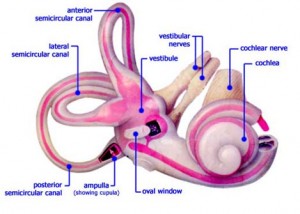As my classmates all know, my interest in vestibular rehabilitation piqued when my father, at age 54, suffered a hemorrhagic stroke which affected his central vestibular system. I was a first-year PT student at the time of his stroke which gave me the opportunity to focus many projects, including this one, on vestibular rehab.
After graduation, I hope to find employment in an orthopedic clinic while also treating patients with vestibular impairments. My goal with this Capstone was to provide the general orthopedic clinician with reference material that can assist them in evaluating, diagnosing, and treating patients with two types of vestibular dysfunctions: Benign Paroxysmal Positional Vertigo (BPPV) or Cervicogenic Dizziness.
I presented information pertaining to posterior and anterior canal BPPV, and cervicogenic dizziness to a group of second-year DPT students this summer. The power point presentation can be seen here: Capstone ppt.
The following documents are meant to be kept in a single binder as reference material in an orthopedic clinic:
vestibular assessment: This is a document which offers a template for specific questions to ask a patient with dizziness, red flags which necessitate referrals, and suggestions for other outcomes measures which may be beneficial in learning more about the patient’s current functional level.
Oculomotor Test instructions: Just as the title suggests, this document gives step-by-step instructions on how to perform the oculomotor examination, both in room light and with blocked vision (Frenzel goggles).
BPPV maneuvers: This document gives the reader step-by-step instructions on tests for the different canals (posterior, anterior, and horizontal) in order to assess which canal is affected. Once the clinician decides which canal they need to treat, this document also has step-by-step instructions and images on the most effective and current treatment approaches.
Nystagmus Patterns_BPPV: This is a table which offers a guide to differential diagnosis of BPPV and which treatments would be best applied for optimal results. It addresses both canalithiasis and cupulolithiasis of all canals.
cervicogenic dizziness: This document gives a brief explanation of the current theories behind cervicogenic dizziness, the most current research on treatment approaches, and which treatments have seen the best results.
Finally, if anyone wishes to review the literature themselves, here is a complete list of resources I used to complete this project:
Thank you to my advisor, Karen McCulloch, and to my committee members for their invaluable feedback and patience. It is more appreciated than you may know.


